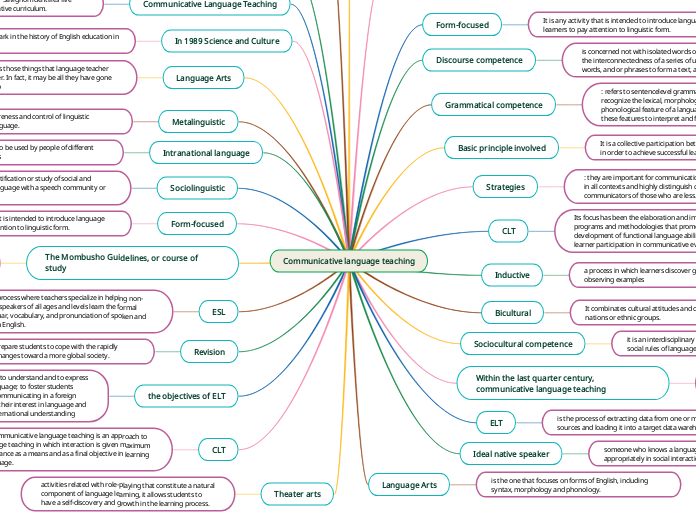
It is any activity that not specifically taught strategies, organizational principles that govern communicative language use but that learners engage with the meaning of structure before paying attention to its form
the ability to communicate effectively with people from different cultures or cultural context.
It is any activity that is intended to introduce language learners to pay attention to linguistic form.
is concerned not with isolated words or phrases but with the interconnectedness of a series of utterances, written words, and or phrases to form a text, a meaningful whole.
: refers to sentencelevel grammatical forms, the ability to recognize the lexical, morphological, syntactic, and phonological feature of a language and to make use of these features to interpret and form words and sentences.
It is a collective participation between learners and teacher in order to achieve successful learning by cooperation.
: they are important for communication and competence in all contexts and highly distinguish competent communicators of those who are less.
Its focus has been the elaboration and implementation of programs and methodologies that promote the development of functional language ability through learner participation in communicative events.
a process in which learners discover grammatical rulers by observing examples
It combinates cultural attitudes and customs of two nations or ethnic groups.
it is an interdisciplinary field of inquiry that has to do with social rules of language use.
) has been put forth around the world as the “new,” or “innovative," way to teach English as a second or foreign language.
is the process of extracting data from one or multiple sources and loading it into a target data warehouse.
someone who knows a language perfectly and uses it appropriately in social interactions.
is the one that focuses on forms of English, including syntax, morphology and phonology.
are the ones we use in unfamiliar situations such as restrictions due to imperfect knowledge of the rules or limiting factors in the application.
it is the use of English for real and immediate communicative purposes.
for the Twenty-First Century" Savignon identifies five components of a communicative curriculum.
stands as a landmark in the history of English education in Japan.
: It is which includes those things that language teacher they often do better. In fact, it may be all they have gone teaching how to do
It involves the awareness and control of linguistic components of language.
a language intended to be used by people of different linguistic backgrounds
It contributes to identification or study of social and cultural effects on language with a speech community or culture.
It is any activity that is intended to introduce language learners to pay attention to linguistic form.
is one of the most important legal precepts in the Japanese educational system. It establishes national standards for elementary and secondary schools.
is the process where teachers specialize in helping non-native speakers of all ages and levels learn the formal grammar, vocabulary, and pronunciation of spoken and written English.
means to prepare students to cope with the rapidly occurring changes toward a more global society.
To develop students ability to understand and to express themselves in a foreign language; to foster students positive attitude towards communicating in a foreign language, and to heighten their interest in language and culture, thus deepening international understanding
The communicative language teaching is an approach to language teaching in which interaction is given maximum importance as a means and as a final objective in learning a language.
activities related with role-playing that constitute a natural component of language learning, it allows students to have a self-discovery and growth in the learning process.